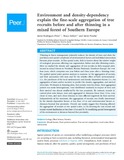Mostrar el registro sencillo del ítem
Environment and density-dependency explain the fine-scale aggregation of tree recruits before and after thinning in a mixed forest of Southern Europe
| dc.creator | Rodríguez Pérez, Javier | es_ES |
| dc.creator | Peralta de Andrés, Francisco Javier | es_ES |
| dc.creator | Imbert Rodríguez, Bosco | es_ES |
| dc.date.accessioned | 2022-10-11T16:02:39Z | |
| dc.date.available | 2022-10-11T16:02:39Z | |
| dc.date.issued | 2022 | |
| dc.identifier.citation | Rodríguez-Pérez, J., Imbert, B., & Peralta, J. (2022). Environment and density-dependency explain the fine-scale aggregation of tree recruits before and after thinning in a mixed forest of Southern Europe. PeerJ, 10, e13892. | en |
| dc.identifier.issn | 2167-8359 | |
| dc.identifier.uri | https://hdl.handle.net/2454/44208 | |
| dc.description.abstract | Thinning in forest management primarily reduces the density of trees and alters the patchiness and spatial complexity of environmental factors and individual interactions between plant recruits. At fine spatial scales, little is known about the relative weight of ecological processes affecting tree regeneration before and after thinning events. Here we studied the density and aggregation of tree recruits in fully-mapped plots located in mixed forests in Northern Iberian Peninsula (Southern Europe) for over four years, which comprises one year before and three years after a thinning event. We applied spatial point-pattern analyses to examine (a) the aggregation of recruits, and their association with trees and (b) the relative effect of both environmental (i.e., the patchiness of the local environment) and density-dependent factors (i.e., the aggregation of trees and/or recruits) to predict the density, aggregation, and survival of recruits. We found, in thinning plots, that recruits were less dense, their aggregation pattern was more heterogeneous, were distributed randomly in respect of trees and their survival was almost unaffected by the tree proximity. By contrast, recruits in control plots were denser, were only aggregated at distances lower than 1.0 m, were closer to trees, and such closer distance to trees affected negatively in their survival. Independently of the treatment, the aggregation of recruits was chiefly determined by the density-dependent factors at less than 1.0 m and environmental factors at distances beyond that proximity. Overall, our results suggest that thinning affected the aggregation of recruits at two spatial scales: (a) by favoring the tree-recruit and recruit-recruit facilitation at less than 1.0 m and (b) by modifying spatial heterogeneity of the environment at distances beyond that proximity. | en |
| dc.description.sponsorship | This research was funded by the Spanish Ministry of Economy and Competitiveness (AGL2006-08288 and AGL2009-11287). Javier Rodríguez-Pérez was funded from the ‘'la Caixa’ and 'Caja Navarra' Foundation, under agreement LCF/PR/PR13/51080004 in the framework of UPNA’s 'Captación de Talento' program. | en |
| dc.format.mimetype | application/pdf | en |
| dc.format.mimetype | application/vnd.oasis.opendocument.text | en |
| dc.language.iso | eng | en |
| dc.publisher | PeerJ | en |
| dc.relation.ispartof | PeerJ 10:e13892 | en |
| dc.rights | Creative Commons Attribution 4.0 International (CC BY 4.0) | en |
| dc.rights.uri | http://creativecommons.org/licenses/by/4.0/ | en |
| dc.subject | Mixed-forests | en |
| dc.subject | Point-pattern analysis | en |
| dc.subject | Tree-recruit competition | en |
| dc.subject | Local scales | en |
| dc.subject | Biotic interactions | en |
| dc.title | Environment and density-dependency explain the fine-scale aggregation of tree recruits before and after thinning in a mixed forest of Southern Europe | en |
| dc.type | Artículo / Artikulua | es |
| dc.type | info:eu-repo/semantics/article | en |
| dc.date.updated | 2022-10-11T06:56:03Z | |
| dc.contributor.department | Ciencias | es_ES |
| dc.contributor.department | Zientziak | eu |
| dc.contributor.department | Institute for Multidisciplinary Research in Applied Biology - IMAB | es_ES |
| dc.rights.accessRights | Acceso abierto / Sarbide irekia | es |
| dc.rights.accessRights | info:eu-repo/semantics/openAccess | en |
| dc.identifier.doi | 10.7717/peerj.13892 | |
| dc.relation.publisherversion | https://doi.org/10.7717/peerj.13892 | |
| dc.type.version | Versión publicada / Argitaratu den bertsioa | es |
| dc.type.version | info:eu-repo/semantics/publishedVersion | en |



